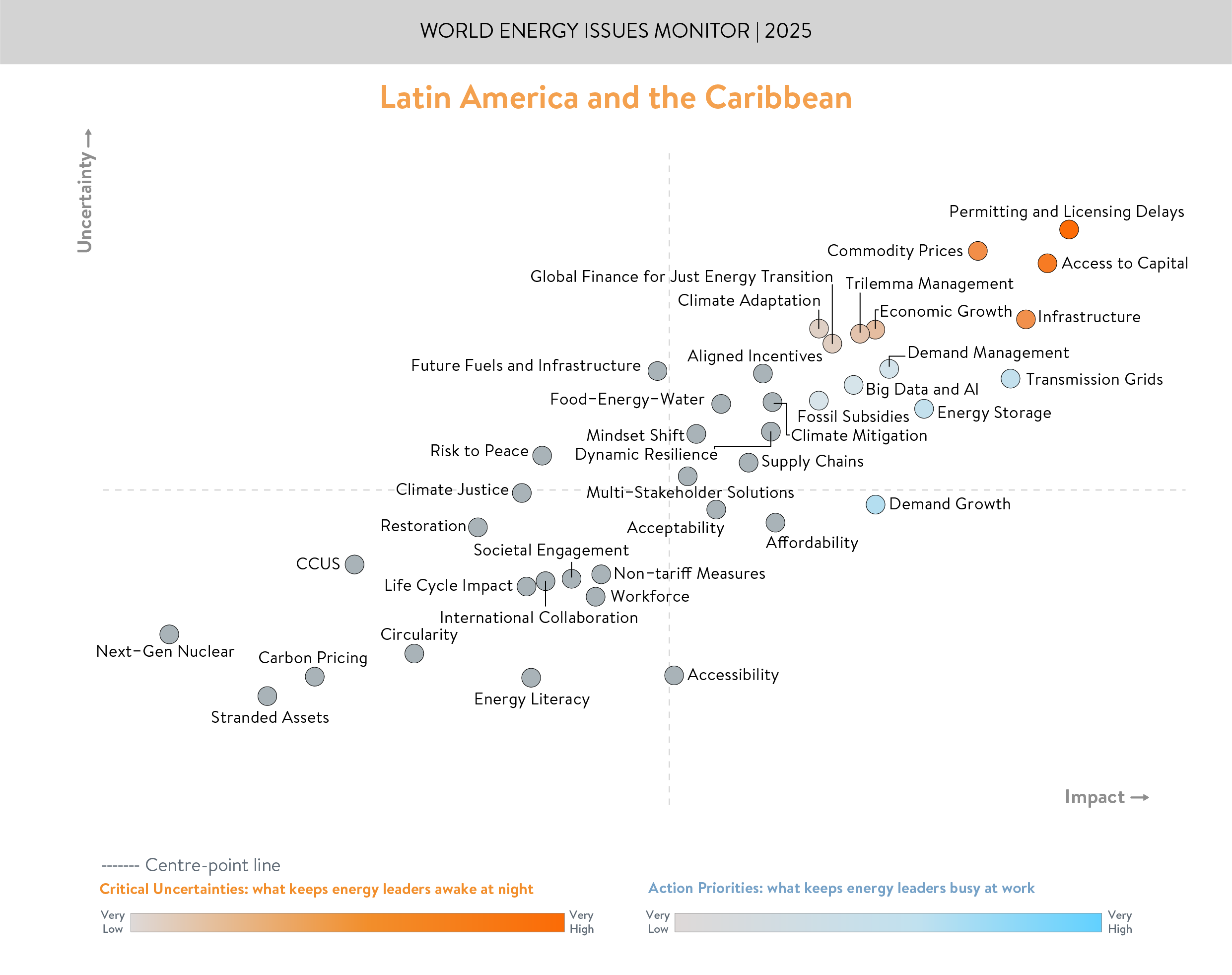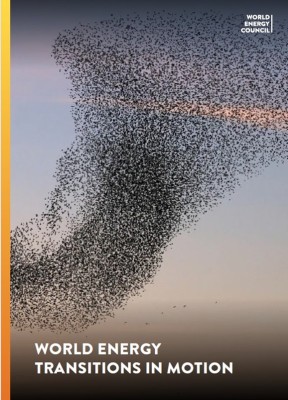Latin America & The Caribbean Network
The Latin American regional network spans from Panama, Ecuador and Colombia in the North to Chile, Uruguay, and Argentina in the South, and includes further countries in central Latin America countries. The extensive network brings together the energy plus community in the region, including Ministers and government officials, CEOs, academics, energy experts, and young energy professionals to discuss and work for a sustainable energy future in the region.
Through events at regional and national level, the development of region-specific content and analysis, an extensive cross-border capacity building programme and collaboration with regional organizations such as the Development Bank of Latin America (CAF), Inter-American Development Bank (“IDB”) and Regional Energetic Integration Commission (CIER), national Member Committees work together to advance energy transition in Latin America and the Caribbean.
Regional action priorities that support the Council’s mission and humanising energy vision are agreed on an annual basis by national Member Committees in the framework of a Regional Action Plan. In 2021, Latin American members agreed to drive forward conversations on the future of hydrogen in the region, extend the reach of “We are all Energy” public awareness campaign across the region, and empower and connect young professionals to take an active role in the regional network.
Each month, the Latin American regional network meets to discuss matters of mutual interest, drive collective activities, and keep each other updated on relevant developments and events. In addition, throughout the year regionally targeted workshops are being organised to advance discussions in the context of our global insights and innovation tools.
Building on the 2020 interest of national Member Committees in the region and a Hydrogen Innovation Forum conducted, members in the region took forward the conversation on clean hydrogen as a promising solution to decarbonise hard to abate sectors such as industry and mobility while providing a seasonal storage solution. Key stakeholders engaged in discussions focussed on demand drivers and economics of hydrogen production and use as well as value chain developments, policy enablers and bottlenecks.
Initiated by the national Member Committee in Chile and the Chilean Agency of Energy Sustainability the “We are all Energy” campaign invites citizens to reflect on how energy, in all its forms, impacts people's life. Through a series of conversations supported by a social media campaign, “We are all Energy” raises public awareness about the role of energy as a key enabler to social and economic development, and the importance of advancing energy transition that leaves no one behind – now and for future generations. The initiative was extended to Argentina and Colombia who shared their local experiences and reflections around humanising energy transition.
Capacity building of professionals in the region has been a priority for national Member Committees for many years. World Energy Academy, a format initiated by the national Member Committee in Argentina (CACME) in 2014, provides professionals from different backgrounds with the tools to understand, assess and inform decisions, and exercise responsible leadership on energy issues. The World Energy Academy currently runs in Argentina, Bolivia, and Colombia.
National Member Committees across the region recognise the importance of empowering young professionals in the region to become actively engaged in and drive regional action priorities. Based on local vision and needs, Future Energy Leaders’ get involved through dedicated national programmes – in Panama, Chile, Argentina, and Uruguay – and / or in cross-border activities. At the same time, they have opportunity to network and interact with their peers and senior energy leaders.
Energy in Latin America and the Caribbean

INTRODUCTION
Latin America and the Caribbean stand at a strategic inflection point in its energy transition journey. The region is home to some of the world’s most abundant and cost-competitive renewable resources – solar, wind, and hydropower – yet widespread deployment and sustained benefits remain constrained by infrastructure bottlenecks, permitting delays, political uncertainty, and social inequities.
The 2025 World Energy Issues Monitor highlights the region's growing demand for reliable, affordable energy amid rapid urbanisation, industrial shifts like nearshoring, and digital infrastructure growth.
Brazil has launched a $30 billion transmission expansion plan to connect remote renewables to industrial centres. Colombia has introduced licensing and tax reforms to fast-track solar and battery storage. Uruguay has achieved a 90%+ renewable power mix and is now electrifying public transport fleets. Efforts such as the SIEPAC transmission system offer early examples of cross-border electricity integration, though broader regional alignment remains a work in progress. Yet, across the region, fragmented regulatory frameworks, weak regional coordination, and limited community engagement continue to slow progress.
Unlocking the region’s clean energy potential – including green hydrogen and wind – will require harmonised policy signals, deeper regional cooperation, and inclusive investment in people and places. If approached strategically, the region can deliver an energy transition that drives sustainable development, enhances resilience, and improves quality of life across diverse geographies
|
ABOUT THE WORLD ENERGY ISSUES MONITOR Energy transitions are complex, evolving, and deeply interconnected, shaped by shifting priorities, emerging uncertainties, and regional realities. Since 2009, the World Energy Issues Monitor has offered a unique lens into the dynamic forces driving energy transitions worldwide. This year’s survey spans 39 core transition issues across six categories – spotlighting blind spots, new signals, and shifting leadership priorities. Amid growing uncertainty, leaders across the World Energy Council community are asking sharper questions: What’s working? What can be adapted across regions? And where are the real opportunities to turn blind spots into bright spots? NOTE ON TIMING AND CONTEXT The world Energy Issues Monitor was conducted between 24 November 2024 and 10 January 2025. The regional workshops that informed the commentary insights took place in the second half of February 2025, before the current trade tensions and the US-led trade tariffs. As such, the regional commentaries should be read in the context in which they were developed, prior to the escalation of current global trade dynamics. |
CRITICAL UNCERTAINTIES AND ACTION PRIORITIES
ABOUT THE WORLD ENERGY ISSUES MONITOR
The region’s extensive renewable energy potential stands ready to advance inclusive growth, yet prolonged and unpredictable approval processes remain a high-impact, high-uncertainty concern.
- Multi-Level Bureaucracy: Lengthy environmental reviews and indigenous consultations processes – though essential – often delay clean energy projects and drive up costs. While important for ensuring community voices are heard, these processes become uncertainty-prone when institutions lack clear frameworks or sufficient staffing.
- Social & Land-Use Dynamics: Many proposed clean energy projects in Chile, Mexico, and other countries face resistance from indigenous or rural communities—often due to the absence of transparent dialogue or equitable benefit-sharing. Incorporating these stakeholders early and substantively can make a decisive difference, unlocking social acceptance and local empowerment.
- Policy Instability: Frequent adjustments to incentive structures or environmental regulations can derail timelines, sowing doubt among development financiers. A consistent, well-publicised policy environment—one that recognizes the socio-economic returns of clean energy—would reduce risk, shorten lead times, and yield stronger local prosperity outcomes.
Top Action Priority: Demand Growth
Energy demand is rising fast—driven by urban growth, industrialisation, and digital infrastructure. Meeting this demand is not only essential for energy security, but also a catalyst for more inclusive growth.
- Industrial Hubs & Urban Development: Rising demand in urban centres and new manufacturing zones is reshaping energy needs. Mexico’s nearshoring boom has spurred new industrial hubs, while cities across Brazil, Colombia, and Argentina require stable electricity for everything from hospitals to small businesses. Ensuring reliable, affordable supply is critical to economic competitiveness and social stability.
- Enhancing Equity & Access: Extending transmission networks and deploying decentralised renewables in underserved areas can bridge persistent energy-access gaps. In remote and rural provinces, electricity access enables productive uses – like agro-processing, education, and digital services – that improve livelihoods. Smart investments in localised infrastructure can unlock lasting socio-economic benefits.
- Digital Infrastructure & E-Mobility: The rise of data centres, electric buses, and EV fleets is rapidly shifting load patterns. Countries such as Chile and Costa Rica are investing in public e-mobility, while Colombia is scaling urban EV use. These trends require forward-looking regulation, demand management tools, and utility readiness to ensure system stability and emissions reduction.
BLIND SPOTS AND BRIGHT SPOTS
Energy transitions have enabled strong progress in some renewable-rich countries, but the entire region’s shift away from conventional fuels lags amid inconsistent permitting and limited public engagement. Efforts to broaden access and industrial competitiveness face uneven momentum. The 2025 data reveals:
Blind Spots
- Community-Led Development Overlooked
Despite pockets of success in wind and solar expansions, community-level ownership and inclusive decision-making remain underemphasized. Projects that rely on top-down approaches—without early involvement of local leaders, rural cooperatives, or indigenous associations—risk protracted resistance or stalled implementation.
- Data Centres and Clean Energy Supply
With the regional data centre market expected to double by 2029, increasing demand for reliable electricity is putting pressure on power infrastructure. While countries like Brazil and Chile are advancing renewable investments, aligning data centre growth with clean energy supply remains complex. Given the region's abundance of solar, wind, and hydropower potential, there is a significant opportunity to meet this rising demand through clean energy expansion. Successful integration will require targeted investments in transmission infrastructure, energy storage, and flexible grid solutions to ensure these power-intensive hubs support regional decarbonisation goals.
- Skilled Workforce Gaps
Many LAC nations excel at training conventional energy engineers but underprepare specialists for emerging domains such as battery storage, AI-driven grid systems, or offshore wind. Meanwhile, female professionals remain underrepresented, limiting sector diversity. Without broader workforce training and upskilling, new installations or expansions can be delayed and reliant on foreign expertise.
|
Energy-Cyber Nexus – Powering LAC’s Digital Growth Responsibly
|
Bright Spots
-
Brazil’s Transmission & Security Strategy
With a $30 billion plan, Brazil extends lines linking remote solar/wind belts to southern industry. Early pilot storage trials hint at improved grid stability and higher integration of new capacity.
-
Colombia’s Streamlined Licensing & Tax Incentives
Recent reforms to environmental licensing and new tax credits for solar or battery expansions ease large-scale deployment. Meanwhile, energy-efficiency outreach fosters local buy-in and incremental cost savings.
-
Uruguay’s Efficiency & Transport Electrification
Uruguay’s 90%+ renewable electricity base shifts focus to electrifying buses and commercial vehicles. The National Energy Efficiency Prize fosters widespread institutional interest in cost-saving retrofits.
|
Key Implications for Humanising Energy – Latin America & The Caribbean
Humanising the region’s energy transition means empowering local communities, bridging gender and skills gaps, and aligning infrastructure with inclusive growth priorities. |
CONCLUSION
Latin America and the Caribbean’s energy transition reflects a dynamic interplay of promise and pressure. While the region possesses world-leading renewable resources and a growing commitment to sustainability, development remains uneven due to political volatility, permitting delays, and limited access to capital
-
Permitting and Licensing delays remain a top uncertainty, driving up costs and stalling clean energy deployment and impacting investor confidence.
-
Transmission Grids are the region’s most urgent action area, with Brazil’s $30 billion investment signalling momentum, though broader regional alignment is needed.
-
Blind Spots – including limited stakeholder and community engagement, uneven access, and workforce gaps risk undermining well-designed projects.
-
Bright Spots include Colombia’s licensing and tax reforms, Uruguay’s advances in electrification and efficiency, and Brazil’s long-term infrastructure planning.
To unlock its full potential, the region must move faster on permitting reform, grid expansion, invest in skills and inclusion, and strengthen regional cooperation. With the right support, Latin America and the Caribbean can lead in delivering just, resilient, and people-centred energy transitions.
KEY CONTRIBUTORS:
In addition to thanking experts from across our community for their contributions, we would like to make special mention of Luiz Carlos Ciocchi, Executive Director of the World Energy Council Brazilian Member Committee; Juan José Mitjans, Executive Director of the World Energy Council Argentine Committee (CACME); Héctor Cotes, CEO of Electron Investment, Panama; and Diego Fernando Vargas Quintero, Head of Engineering and Training at the World Energy Council Colombia Member Committee.
Downloads

World Energy Issues Monitor 2025
Download PDF







